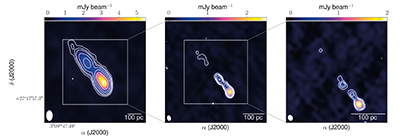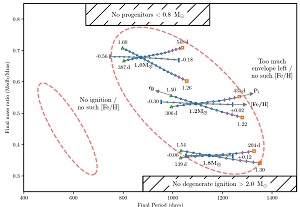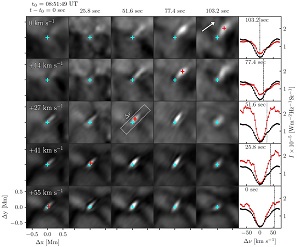Parsec-scale properties of the radio brightest jetted AGN at z >6 (Spingola et al.)
- Details
- Published on 11 November 2020
Vol. 643
1. Letters
Parsec-scale properties of the radio brightest jetted AGN at z >6

Blazars are powerful quasars with accretion disks that are nearly face-on. Additionally, their light beams and radio jets are approximately located along the line of sight and thus experience Doppler boosting. They tend to be under-abundant at high redshift with respect to the local universe. The authors report on the very long baseline interferometry of the most powerful jetted active galactic nuclei at z>6. Using milliarcsecond resolution, they discovered a bright one-sided jet about 500 pc long in projection that is resolved into multiple clumps. They derived its viewing angle as well as its Lorentz and Doppler factors. Surprisingly, its bulk Lorentz factor appears to be relatively low (less than 5), which might explain the paucity of high-z blazars with respect to current predictions. However, other scenarios have not been ruled out. More stringent constraints on this jet and other high-z blazars will be needed to form conclusions regarding the possible z-evolution of the blazar population.
A stringent upper limit of the PH3 abundance at the cloud top of Venus
- Details
- Published on 27 October 2020
Vol. 643
1. Letters to the Editor
A stringent upper limit of the PH3 abundance at the cloud top of Venus
A recent candidate detection of the phosphine molecule (PH3) with JCMT and ALMA in the upper atmosphere of Venus has incited a great deal of public interest. Phosphine is not expected to survive long in the highly oxidizing atmosphere of Venus, and its tentative detection has therefore been speculated to reflect biological processes in the Venusian atmosphere. Encrenaz et al. use observations of a 10 micrometer transition of phosphine to set an upper limit on its abundance at and slightly above the top of the Venus clouds. That limit is, at the 3 sigma confidence level, a factor of four lower than the PH3 abundance derived from the tentative millimeter-wave detection. The millimeter-wave transition of PH3 probes higher levels of the Venus atmosphere than the 10 micrometer transition, leaving the two results formally compatible; however, the tight upper limit obtained by Encrenaz et al. sets very strong constraints on phosphine production in Venus.Modeling protoplanetary disk SEDs with artificial neural networks. Revisiting the viscous disk model and updated disk masses
- Details
- Published on 16 October 2020
Vol. 642
6. Interstellar and circumstellar matter
Modeling protoplanetary disk SEDs with artificial neural networks. Revisiting the viscous disk model and updated disk masses
There are still several open questions in our understanding of planet formation, including the main mechanism responsible for angular momentum transport in protoplanetary disks or their apparent low masses compared to those of exoplanetary systems. Investigating these types of issues requires disk models that account for many physical processes, which also makes them computationally demanding. As a result, modeling large samples of disks can usually only be achieved with simpler models. In this work, Ribas et al. combine physically motivated viscous disk models with artificial neural networks to drastically speed up their computation times, which allows for modeling of spectral energy distributions of protoplanetary disks with detailed models using a Bayesian framework. Applying this approach to 23 protoplanetary disks in the Taurus-Auriga star-forming regions yields high viscosity values for many of them, which is in contradiction with recent ALMA results. This suggests that mechanisms other than viscosity could play a significant role in the transport of angular momentum in disks. The disk masses derived using full radiative transfer models are also systematically higher than those derived from (sub)mm fluxes alone, which could help alleviate the observed discrepancy between the masses of disks and exoplanetary systems.
A global model of particle acceleration at pulsar wind termination shocks
- Details
- Published on 13 October 2020
Vol. 642
2. Astrophysical processes
A global model of particle acceleration at pulsar wind termination shocks
Pulsar wind nebulae are among the brightest Galactic nonthermal sources at high energies, up through TeV, testifying to the efficient acceleration of charged particles in the vicinity of the central neutron star. Determining how to reach the required energies has been a challenging problem for decades. This study uses a schematic but physically plausible representation of the latitude-dependent pulsar wind and magnetic field into which leptons (electron-positron) are injected. The time dependent flow forms a shock, whose structure rapidly becomes macroscopically turbulent. The simulation uses a fully relativistic particle-in-cell (PIC) code, Zeltron, to follow the diffusive particle energization through this tangle of filamented structures at the termination shock of the wind with its surrounding interstellar medium (ISM). The formation of the shock over time is a result of the simulation and it is not pre-imposed, hence the complex structure development can be followed. This is perhaps the most intriguing result of the modeling, that is to say the synchrotron emission in different energy ranges is diagnostic for the site of origin: The highest energy emission comes from the turbulent regions imbedded within shock cavities and it is boosted and beamed by the local bulk motions at the shock.
ROSINA ion zoo at Comet 67P
- Details
- Published on 29 September 2020
Vol. 641
10. Planets and planetary systems
ROSINA ion zoo at Comet 67P

Popularized as the "cometary Zoo,” the richness of cometary neutral composition has been revealed at comet 67P Churyumov-Gerasimenko by the ROSINA instrument on board ESA's Rosetta mission. The ionization of neutrals by extreme ultraviolet radiation and energetic electrons produces cometary ions, whose subsequent reactions and collisions with neutrals may further enrich ion composition. Cometary atmosphere ionosphere models have thus predicted a whole suite of cometary cations, but remote sensing detections have been relatively scarce, and earlier in situ mass spectrometry on Giotto had insufficient mass resolution to distinguish between ion species of a similar mass. The situation has dramatically changed with the operation of ROSINA at comet 67P with a mass resolution of up to 3000, permitting, for example, one to distinguish 13C+ from CH+. Here, Beth et al. report on the detailed composition of the ionosphere of comet 67P, establishing the presence of many predicted catio! ns such a s CH_m+ (m = 1-4), H_nO (n=1-3), O+, Na+, and several ionized and protonated molecules (e.g., C2H4+, C2H5+, and CH3OH2+). A particular highlight is the discovery of CO2++, which was produced by the direct ionization of CO2, which represents the first detection of a molecular dication in any gas envelope in the Solar System.
The path to instability in compact multi-planetary systems
- Details
- Published on 28 September 2020
Vol. 641
10. Planets and planetary systems
The path to instability in compact multi-planetary systems

Three or more compact planetary systems can become unstable on timescales of up to billions of years. Predicting their stability is challenging and numerically expensive due to the chaotic dynamics, and, until now, there has been no theoretical understanding of the nature of the mechanism driving the instability. Based on numerical simulations, it had been postulated that the system's survival time follows an exponential trend in the planet orbital separation measured in units of Hill radii. Contrary to a constant diffusion process, planetary systems seem to remain dynamically quiescent for most of their lifetimes prior to a very short unstable phase. In this work, Petit and colleagues study a two-phase mechanism in which the slow chaotic diffusion due to the overlap of three-body resonances dominates the instability timescale prior to a rapid scattering phase triggered by the crossing of a two-planet mean motion resonance. They obtain an analytical estimate of the survival time that is consistent with numerical simulations over four orders of magnitude for the planet-to-star mass ratio, and six to eight orders of magnitude for the instability time. They also confirm that measuring the orbital spacing in terms of Hill radii is not suitable and that the correct spacing unit scales have a flatter dependency in the planet mass. Their model reproduces the observation that the survival time increases beyond a certain spacing since the three-planet resonances do not overlap.
Observed binary populations reflect the Galactic history
- Details
- Published on 25 September 2020
Vol. 641
10. Planets and planetary systems
Observed binary populations reflect the Galactic history

The authors demonstrate, for the first time, that the observed orbital period-mass ratio correlation of subdwarf B (sdB) binaries is caused by the metallicity history of our Galaxy. Metal-rich low-mass stars have larger radii at the tip of the first giant branch (FGB) than metal-poor low-mass stars. Consequently, the stable mass transfer of a metal-rich low-mass donor star ascending to the tip of the FGB leads to the formation of sdB binaries with longer orbital periods. The narrow sdB mass range, the narrow mass ratio range in the original binaries which lead to sdBs, and the Galaxy chemical evolution model, therefore, create the observed strong P-q correlation. We may see similar metallicity effects for other binaries which resulted from stable mass transfer of low-mass red giant donors, and we may expect that the accurately measured properties of the low-mass exotic binaries will provide new constraints on chemical evolution studies of the Galaxy.
The First Billion Years project: Finding infant globular clusters at z=6 ( Phipps et al.)
- Details
- Published on 22 September 2020
Vol. 641
5. Galactic structure, stellar clusters and populations
The First Billion Years project: Finding infant globular clusters at z=6
Globular clusters (GCs) are among the oldest gravitationally bound stellar systems as they are characterized by stellar populations with ages of 11.5 to 12.5 Gyr. They probably formed during, or just after, the epoch of reionization; therefore, the study of these systems at high redshift cannot only give insight into the processes and environments that governed star formation at that time, but they can also represent valuable probes of the reionization epoch itself. In this work, the authors conduct an analysis of the demographics and global properties of low-mass stellar systems at high redshift, within the numerical framework of the FiBY cosmological simulations. They identify a population of dense objects with M*<10^4 Msolar, such that the fraction of baryons (over the total mass of baryons and dark matter) is close to unity; they suggest that these objects are possible infant GC candidates. Compared to present-day GCs in the local Universe, these infant GCs have a higher gas fraction and consistently appear to be more extended with the properties of the few examples of proto-globulars currently observed at high-redshift. Forthcoming studies will examine the origin and future evolution of these systems to further progress our understanding of the role of low-mass stellar systems in early galaxy formation.Signatures of ubiquitous magnetic reconnection in the lower solar atmosphere (Joshi et al.)
- Details
- Published on 04 September 2020
Vol. 641
9. The Sun and the Heliosphere
Signatures of ubiquitous magnetic reconnection in the lower solar atmosphere
 Magnetic reconnection is a fundamental physical process that governs a variety of high energy dynamics in the solar atmosphere, such as flares and coronal mass ejections. In the lower solar atmosphere, small-scale magnetic reconnection manifests as intense and compact brightenings in the wings of the hydrogen Balmer-a line; these manifestations are known as Ellerman bombs. Ellerman bombs are constituents of magnetically active solar regions and magnetic flux-emerging regions. Very recently, a phenomenon analogous to Ellerman bombs was discovered in regions of minimal magnetic activity on the solar surface, the quiet Sun, and termed as quiet Sun Ellerman bombs. Quiet Sun Ellerman bombs are the smallest observable magnetic reconnection phenomenon in the lower solar atmosphere. In this Letter, the authors, using high spatial resolution observations in the hydrogen Balmer-b line from the Swedish 1-m Solar Telescope, report that quiet Sun Ellerman bombs are ubiquitous and nearly uniformly distributed throughout the solar surface; there could be about half a million quiet Sun Ellerman bombs on the solar surface at any given time. The presented observations indicate that the magnetic reconnection leading to quiet Sun Ellerman bombs takes place in vertically extended current-sheets in intergranular lanes extending between the photosphere and chromosphere. It will be of great interest to study the role of this ubiquitous small-scale magnetic reconnection phenomenon in chromospheric and coronal heating.
Magnetic reconnection is a fundamental physical process that governs a variety of high energy dynamics in the solar atmosphere, such as flares and coronal mass ejections. In the lower solar atmosphere, small-scale magnetic reconnection manifests as intense and compact brightenings in the wings of the hydrogen Balmer-a line; these manifestations are known as Ellerman bombs. Ellerman bombs are constituents of magnetically active solar regions and magnetic flux-emerging regions. Very recently, a phenomenon analogous to Ellerman bombs was discovered in regions of minimal magnetic activity on the solar surface, the quiet Sun, and termed as quiet Sun Ellerman bombs. Quiet Sun Ellerman bombs are the smallest observable magnetic reconnection phenomenon in the lower solar atmosphere. In this Letter, the authors, using high spatial resolution observations in the hydrogen Balmer-b line from the Swedish 1-m Solar Telescope, report that quiet Sun Ellerman bombs are ubiquitous and nearly uniformly distributed throughout the solar surface; there could be about half a million quiet Sun Ellerman bombs on the solar surface at any given time. The presented observations indicate that the magnetic reconnection leading to quiet Sun Ellerman bombs takes place in vertically extended current-sheets in intergranular lanes extending between the photosphere and chromosphere. It will be of great interest to study the role of this ubiquitous small-scale magnetic reconnection phenomenon in chromospheric and coronal heating.
Fully compressible simulations of waves and core convection in main-sequence stars (Horst et al.)
- Details
- Published on 01 September 2020
Vol. 641
2. Astrophysical processes
Fully compressible simulations of waves and core convection in main-sequence stars
Turbulent core convection provides one mechanism to excite stellar oscillations (e.g. internal gravity waves) that amplify and disperse in the interior as they propagate. The corresponding surface wave spectra and signatures are still being debated within current investigations using multidimensional hydrodynamical simulations. While many approaches use a modified version of the equations of hydrodynamics as a basis for modeling, the method presented in the paper also accounts for compressibility effects and is thus able to recover acoustic waves in addition to internal gravity waves.


